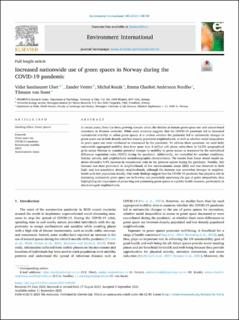| dc.contributor.author | Ulset, Vidar Sandsaunet | |
| dc.contributor.author | Venter, Zander | |
| dc.contributor.author | Kozak, Michal | |
| dc.contributor.author | Nordbø, Emma Charlott Andersson | |
| dc.contributor.author | von Soest, Tilmann Martin | |
| dc.date.accessioned | 2024-02-12T10:59:42Z | |
| dc.date.available | 2024-02-12T10:59:42Z | |
| dc.date.created | 2023-09-26T10:16:51Z | |
| dc.date.issued | 2023 | |
| dc.identifier.citation | Environment International. 2023, 180 . | |
| dc.identifier.issn | 0160-4120 | |
| dc.identifier.uri | https://hdl.handle.net/11250/3116863 | |
| dc.description.abstract | In recent years, there has been growing concern about the decline in human green space use and nature-based recreation in Western countries. While some evidence suggests that the COVID-19 pandemic led to increased recreational mobility in urban green spaces, it is unclear whether the pandemic led to nationwide changes in green space use in both densely and less densely populated neighborhoods, as well as whether social inequalities in green space use were reinforced or attenuated by the pandemic. To address these questions, we used daily nationwide aggregated mobility data from more than 2 million cell phone subscribers in 14,331 geographical grids across Norway to examine potential changes in mobility in green spaces as measured by the normalized difference vegetation index (NDVI) during the pandemic. Additionally, we controlled for weather conditions, holiday periods, and neighborhood sociodemographic characteristics. The results from linear mixed model analyses showed a 9.4% increase in recreational visits in the greenest spaces during the pandemic. Notably, this increase was most prominent in neighborhoods of low socioeconomic status (SES) and was observed in both high- and low-population density neighborhoods, although the increase was somewhat stronger in neighborhoods with low population density. Our study findings suggest that the COVID-19 pandemic has played a role in increasing nationwide green space use in Norway and potentially narrowing the gap of green inequalities, thus highlighting the importance of preserving and promoting green spaces as a public health resource, particularly in disadvantaged neighborhoods. Green space use COVID-19 pandemic Recreational mobility NDVI Sosioeconomic status | |
| dc.language.iso | eng | |
| dc.title | Increased nationwide use of green spaces in Norway during the COVID-19 pandemic | |
| dc.title.alternative | Increased nationwide use of green spaces in Norway during the COVID-19 pandemic | |
| dc.type | Peer reviewed | |
| dc.type | Journal article | |
| dc.description.version | publishedVersion | |
| dc.subject.nsi | VDP::Samfunnsgeografi: 290 | |
| dc.subject.nsi | VDP::Human geography: 290 | |
| dc.subject.nsi | VDP::Samfunnsgeografi: 290 | |
| dc.subject.nsi | VDP::Human geography: 290 | |
| dc.source.pagenumber | 9 | |
| dc.source.volume | 180 | |
| dc.source.journal | Environment International | |
| dc.identifier.doi | 10.1016/j.envint.2023.108190 | |
| dc.identifier.cristin | 2178857 | |
| dc.relation.project | Norges forskningsråd: 300816 | |
| dc.relation.project | Norges forskningsråd: 288083 | |
| cristin.ispublished | true | |
| cristin.fulltext | original | |
| cristin.qualitycode | 1 | |
